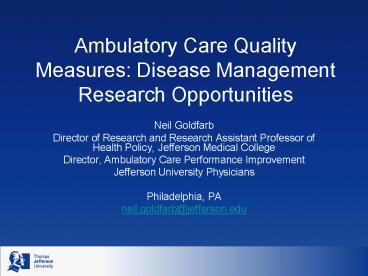Ambulatory Care Quality Measures: Disease Management Research Opportunities - PowerPoint PPT Presentation
Title:
Ambulatory Care Quality Measures: Disease Management Research Opportunities
Description:
Title: Characteristics Related to Productivity Loss in Patients with Overactive Bladder: Results from the MATRIX Study Author: art006 Last modified by – PowerPoint PPT presentation
Number of Views:96
Avg rating:3.0/5.0
Title: Ambulatory Care Quality Measures: Disease Management Research Opportunities
1
Ambulatory Care Quality Measures Disease
Management Research Opportunities
- Neil Goldfarb
- Director of Research and Research Assistant
Professor of Health Policy, Jefferson Medical
College - Director, Ambulatory Care Performance Improvement
- Jefferson University Physicians
- Philadelphia, PA
- neil.goldfarb_at_jefferson.edu
2
This Presentation will Answer
- Who am I and why am I here?
- What are the national measurement sets?
- Who is using the measures and how?
- What are the opportunities for Disease Management
programs and future research? - What do YOU think? (discussion)
3
About DHP
- Jefferson Medical College
- Department of Health Policy
- DM Evaluation
- Ambulatory Quality Measurement
- Jefferson University Physicians
- Clinical Care Committee
4
Trends in Quality Measurement
- Structure gt process gt outcome
- Inpatient gt outpatient
- Health plan level gt provider level
- Primary care gt specialties
5
Ambulatory Quality Measurement Systems
- NCQA / HEDIS
- AQA
- National Quality Forum
- CMS PQRI
- AHRQ National Quality Report Card
- Other Professional Society Measures
- Other
6
HEDIS EFFECTIVENESS OF CARE MEASURES
- CHILDHOOD/ADOLESCENT IMMUNIZATION
- TREATMENT OF CHILDHOOD URI
- MAMMOGRAMS AND PAPS
- COLON CANCER SCREENING
- CHLAMYDIA SCREENING
- BETA BLOCKERS POST MI
- ANTIDEPRESSANTS
- MEDICARE OSTEOPOROSIS, FLU SHOTS AND PNEUMONIA
VACCINE, HEALTH OUTCOMES, INCONTINENCE
- CONTROLLING HIGH BLOOD PRESSURE
- CHOLESTEROL MANAGEMENT POST CARDIOVASCULAR EVENT
- COMPREHENSIVE DIABETES CARE
- FLU SHOTS FOR SENIORS
- MENTAL HEALTH OUTPATIENT FOLLOW-UP
- SMOKING CESSATION
- APPROPRIATE ASTHMA MEDS
7
AQA Starter Set
- Coronary Artery Disease (CAD)
- 8. Drug Therapy for Lowering LDL Cholesterol
- 9. Beta-Blocker Treatment after Heart Attack
- 10. Beta-Blocker Therapy Post MI persistent
treatment - Heart Failure
- 11. ACE Inhibitor /ARB Therapy patients who also
have LVSD - 12. LVF Assessment
- Prevention Measures
- 1. Breast Cancer Screening mammogram
- 2. Colorectal Cancer Screening FOBT or flexible
sigmoidoscopy - 3. Cervical Cancer Screening Pap test
- 4. Tobacco Use queried
- 5. Advising Smokers to Quit
- 6. Influenza Vaccination Ages 50-64
- 7. Pneumonia Vaccination
8
AQA Starter Set (continued)
- Diabetes
- 13. HbA1C Management
- 14. HbA1C Management Control gt9.0poor control
- 15. Blood Pressure Management lt140/90 mm Hg
- 16. Lipid Measurement 1 LDL-C test or ALL
component test - 17. LDL Cholesterol Level (lt130mg/dL) patients
with diabetes - 18. Eye Exam
- Asthma
- 19. Use of Appropriate Medications
- 20. Asthma Pharmacologic Therapy
- Depression
- 21. Antidepressant Medication Acute Phase
- 22. Antidepressant Medication Management
Continuation Phase
9
AQA Starter Set (continued)
- Prenatal Care
- 23. Screening for Human Immunodeficiency Virus
- 24. Anti-D Immune Globulin D (Rh) negative,
unsensitized patients, 26-30 weeks gestation.
- Quality Measures Addressing Overuse or Misuse
- 25. Appropriate Treatment for Children with Upper
Respiratory Infection (URI) - 26. Appropriate Testing for Children with
Pharyngitis
10
CMS Physician Quality Reporting Initiative (PQRI)
- Formerly PVRP
- G-codes shifting to CPT codes
- Requires changes to billing procedures
- Applies to Medicare only (for now)
- Rapidly evolving
11
Sample PQRI Ambulatory Quality Measures
- Diabetes HbA1c, LDL, BP control
- Heart Failure ACE and ARB, Beta blockers
- CAD Anti-platelet therapy, Beta blockers
- Osteoporosis management post fracture
- Management of urinary incontinence
- Appropriate pharmacotherapy for asthma
12
Use of the Measures
- Public reporting initiatives
- Pay for Performance
- Selective contracting
- Tiering and steering
13
Implications for DM
- Increased measurement standardization
- Broadened array of populations of interest
- Increased accountability
- Increased incentive for providers to collaborate
with DM efforts - New opportunities to contract directly with
provider groups and systems
14
Challenges
- HIT availability, cost, and inter-operability
- Measurement set and specifications in state of
rapid evolution - Financial incentives are still modest
- Consumers are not yet fully engaged
- Patient compliance and adherence are not
considered in measurement - Many measures not yet validated
15
Sample Research Questions
- Does DM improve ambulatory quality?
- Which components of DM are most associated with
improvements? - Does provider cooperation and satisfaction with
DM increase? - Does cost-effectiveness of DM increase or
decrease as quality measures proliferate? - What impact does provider P4P have on DM program
use and effectiveness?






























